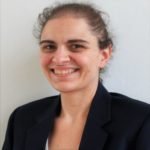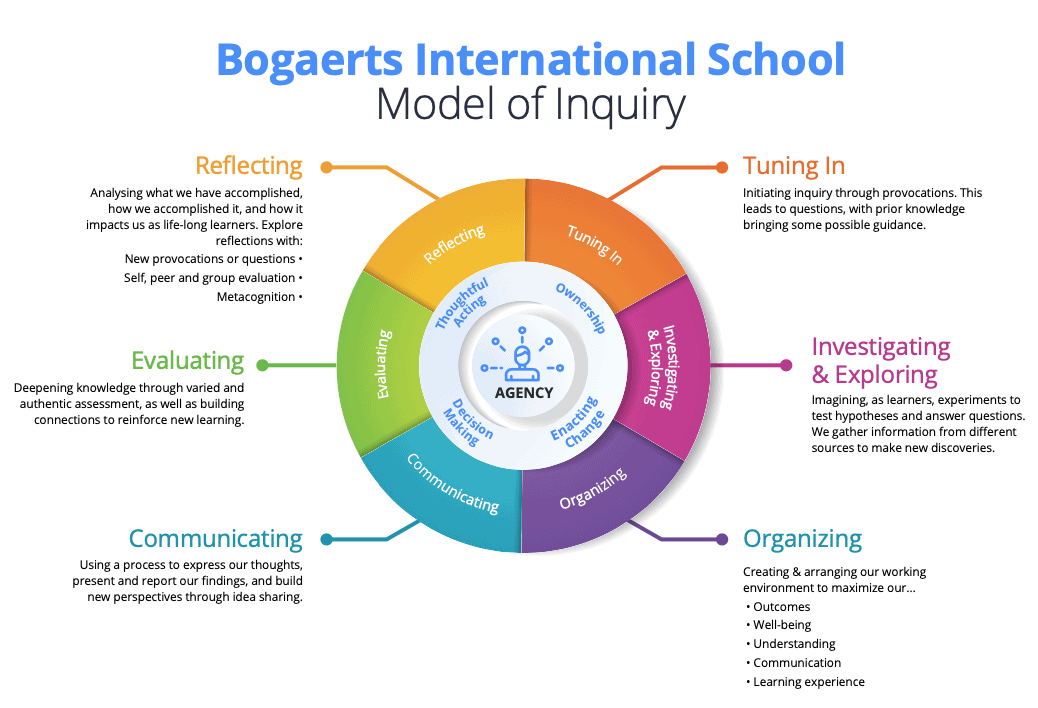Written by Danielle Robertson, PYP Coordinator/Dean of Students, Bogaerts International School
Our school’s long and provocative journey through the PYP authorization process ended victoriously in March of 2019. After nearly three years of tireless effort, we were triumphant! Of course, as any IB school (or excellent educator) knows, one’s work never ceases. Amongst all of the helpful feedback from our visiting team was a request that we decided to place above all others – the request to form a dedicated model of inquiry for our school. The demand, at first, shocked us all.
We were already deeply familiar with inquiry based learning asking questions, right? Curiosity! Project based learning! Inquirers is a learner profile trait, for Pete’s sake. Surely, we were implementing a rich, inquiry based curriculum already, without a model. The answer, maybe even more shockingly, was “no, we really aren’t.” We weren’t teaching poorly, on the contrary, we are a dedicated bunch and we devote hours upon hours to our craft. We collaboratively planned, we taught almost all of our curriculum within units of inquiry (a struggle in and of itself for maths and science), and we focused on conceptual, universal, and relevant learning opportunities. But it wasn’t until we decided to pursue the process of making this model that we truly understood what inquiry based learning could be, and how many opportunities were passing us by.
Designing a Site Based Understanding of Inquiry
So, where does one start when one wants to build a model, or a blueprint, for effective use? We chose to start with the construction of a working definition of “inquiry based learning.” Everyone is familiar with the jargon, the buzz words, but what is this approach in concrete practice? What does the research say? What do the theoretical and practical voices in education say? As a PYP coordinator, it seemed most responsible for me to gather up various, competing definitions of the term and then ask our team to synthesize from past experience, expert information, and our understanding of the school’s culture of learning, a definition that suited the school’s guiding statements (our mission, vision, and philosophy). Seems simple enough...right?
After examining and discussing, as a PYP staff, multiple definitions and musings from sources far and wide, and then listing shared keywords or particularly poignant phrasing, we honed a definition that we believed captured the essence of what inquiry based education is to us:
Inquiry is a student centered approach that promotes curiosity and discovery through questioning and investigation; this enables students to take ownership of their learning and develop skills that will benefit them as responsible and life long learners.
Stepping Into the Unfamiliar
This was a first step into what was relatively unfamiliar territory for us. As progressive 21st century educators, we embraced the well known IB concept of “student initiated action.” This is a cornerstone of the enhanced PYP, but as many schools before us, we struggled with the seemingly paradoxical idea of inspiring students to do things without direct interference or at least subtle persuasion or suggestion.
“Inquiry based learning, as we were discovering piece by piece, would hopefully be the answer to this riddle we’d faced since applying for candidacy.”
Furthermore, as we delved more and more into the enhanced PYP and its emphasis on student agency, the need for less interference was becoming quite urgent. We had clearly demonstrated our high level of skill, as a faculty, with eliciting genuine and enthusiastic participation in our curriculum. However, within our authorization report, we still noted a struggle with “letting go of the reins,” so to speak, and becoming true champions of student led learning. Developing our model of inquiry would, hopefully, assist us in releasing some of that curricular control to the learners themselves.
So, armed with our new definition, we began to examine existing models of inquiry from dozens of schools. Teachers took the time to add to a collection of models of all shapes, sizes, colors, and content. This portion of our journey was very much like a science project – we had a method to follow! We first collected a large body of data. Then, we observed the data and analysed it. What patterns did we see? What did shapes and colors tell us? What information is shared across models? What information speaks to our community most accurately and our definition of inquiry? Finally, it was time to start making decisions.
Building a Model
First, and most fervently, we knew that a circle was simply the only shape that would suit our model. Linear learning, with a beginning and end, was too finite; a story of learning never really ends, even when the topic is shifted. So, a circle it was.
Second, we knew that we needed steps in our continuum of learning. We also knew that the best models shared, with very little exception, had the same six steps. Those are reflected in our final product, and are generally the core of any good inquiry model. What we did take the time to develop independently were the descriptions of each of those steps. Using small group work, we very carefully considered these descriptions, as these would become the “manual” for applying this model to every learning task, and every assessment or unit that we chose to plan. If there’s one immutable truth about these sorts of conceptual models and education theories, it’s that practicality is not always a consideration. The last thing we wanted was to create a beautiful, appealing model that would satisfy the public eye but prove to be useless in the planning process!
Finally, we knew that we wanted to represent the core values of the enhanced PYP within the model. These were values that we spent a summer examining, and we consider them to be at the center of everything that we create or scaffold for the students. We enthusiastically credit the IB programme graphics for inspiring the middle of our inquiry wheel – we share the belief that student agency, the ownership of one’s decisions and actions, rest at the core of our educational goals. In the end, this is precisely what we want our students to be able to do. There was no better way to remind us, as teachers, that those are the fruits of our labor, should we fully commit to an inquiry based learning experience for our classrooms.
Well, that’s a fine model, done and dusted. However, there’s still the problem of “letting go.” It’s one thing to talk the talk of student led learning; it’s another issue entirely to walk the walk. As many of our students require mentorship and guidance to begin courageously asking questions and exploring their own minds and the world around them, we too required guidance about releasing more and more control over the direction of learning to our students. Enter: the levels of inquiry.
The levels of inquiry are an addendum to our model. Inquiry based educational expert and speaker Trevor Mackenzie’s work (as inspired by Nancy Fichtman Dana, I believe) suggests that student inquiry exists on four levels, ranging from tightly controlled “structured inquiry” (inquiry that is being totally overseen by the teacher and is whole class based) to the rather frightening notion of “free inquiry” (inquiry in which students choose their own topics, without any prescribed outcome, and are responsible for both the process and product of their own learning).
Despite my use of the word “frightening” to describe “free inquiry,” is that not the end game for any student of the PYP? The exhibition, is, at its heart, a free inquiry experience. So, how can we get from structured to free inquiry to end a student’s PYP experience properly, without being able to turn learning over to the pupils?
At Bogaerts, we still haven’t fully answered this last, daunting question. However, we continue to persevere. We design our units and learning activities with a modified planner that fully embraces our new model of inquiry. We hold fast to our commitment to promoting student agency and ownership of learning. To help us take baby steps toward free inquiry we have even provided ourselves with a “scope and sequence” of inquiry – what level of inquiry our students should have mastered within given age groups. These structures, though somewhat ironic (given that we are trying to eliminate certain structures by adding more structures...), represent what it really takes to provide students with opportunities to support agency within their learning: a mountain of hard work behind the scenes. We are the duck floating gracefully on the lake...paddling furiously with our webbed feet under the surface.
However, given the direction that the world is headed in, there can be no greater goal in any school that wishes to prepare its students for life in the 21st century than giving its students the confidence and skills required to make sound and healthy decisions in a constantly changing environment. Our model of inquiry, we hope, will empower us to empower our students.
You can read more articles like this in our new Curriculum Magazine:
 Danielle Robertson currently serves as the PYP Coordinator and whole school Dean of Students for Bogaerts International School in Brussels, Belgium. She has served at this school as a teacher and learning community leader for the last five years, and immigrated to Belgium in 2013. She has been an educator since 2002.
Danielle Robertson currently serves as the PYP Coordinator and whole school Dean of Students for Bogaerts International School in Brussels, Belgium. She has served at this school as a teacher and learning community leader for the last five years, and immigrated to Belgium in 2013. She has been an educator since 2002.


